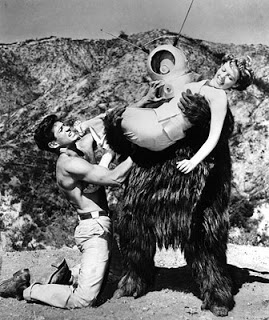 |
| If only she could scream louder! It might defeat Ro-Man |
In the 1953 B-movie, Robot Monster, protagonists Alice (Claudia Barret) and Roy (George Nader) attempt to engage in post-apocalyptic frolicking and fornicating. This is all while being pursued by a gorilla-suited socialism-spewing space man (John Brown). This space man, or as he calls himself, Ro-Man, falls in love with Alice. How could a communist alien from the stars resist a red-blooded American woman? Exactly. Impossible.
Unfortunately for Ro-Man, his love is unrequited. So, he does what any oversized hairy simian does. He launches an impromptu kidnapping. While Alice kicks and screams in his arms, he awkwardly saunters across the desert countryside. But, it is Alice’s screams that are of particular interest. While fighting Ro-Man, Roy grunts and groans but he doesn’t issue the same prolonged tone of terror that Alice does. Alice’s only “action” is to indicate her utter passiveness via screaming. Roy gets to act and rescue.
The woman’s scream has been an essential part of horror. Women play a fundamental role in horror films – possibly more than other genres. Women function as a foil. They are wrought by terror. They scream the way we, in the theater, want to.
The archetypes we see presented in B-movies extend into the classic horror canon. Some of the great horror movies wouldn’t be the same without the woman’s scream.
Psycho featured one of the more famous screaming scenes on the silver screen. What is brutal about this Alfred Hitchcock film is that we follow a faux-protagonist for a long time, Marion (Janet Leigh), only to see her abruptly and brutally murdered. Her role is to be lost to terror and die shrieking.
The thing about Psychoand Robot Monster is that they position their female characters in both terrifying and erotic situations. Alice is swept away by Ro-Man from her dalliances with Roy. Marion is murdered while in the shower. Their screams can be reminiscent of orgasm.
This is pretty typical in any horror movie – especially the ones featuring young people getting indirectly punished for sexual activity (as in: any horror movie since the ‘80s.)
There’s got to be a better place for women in horror films.
And there is. But, it’s complicated.
There are strong women characters in horror movies – ones that rarely scream, and if they do it is with purpose. Ripley (Sigourney Weaver) from the Alien films has got to be one of the bad-assest of horror heroes out there. She’s calm, steely and a survivor. Buffy (Sarah Michelle Gellar) from Buffy the Vampire Slayeris also an admirable kicker of supernatural asses. Women can be tough in horrific situations.
It’s not the norm, though.
 |
| I mean, in all likelihood, you would scream in her situation. |
In Stanley Kubrick’s The Shining, Wendy (Shelley Duvall), the chirpy wife to the murderously insane Jack Torrance (Jack Nicholson), spends the last half of the movie in hysterics. It seems like a pretty appropriate reaction to your husband losing his mind and trying to kill you. She does ultimately save herself and her son, but it’s in a human and clumsy sort of way.
This should be ok – but against a backdrop of hysterical women, Wendy becomes a part of the passive amalgam.
The problem is that we are still dealing with an either-or sort of situation. Women can be preternaturally courageous and stoic. Or, they can be spastic screeching machines that fall to pieces.
We need more nuance. While horror is not the first place you look for complex characters, we can do better than fitful women standing in for the audience’s own desire to scream.
